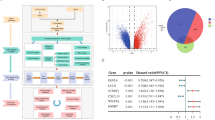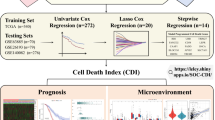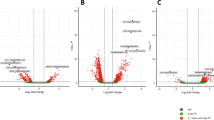Abstract
Purpose
HGSOC is a kind of gynecological cancer with high mortality and strong heterogeneity. The study used multi-omics and multiple algorithms to identify novel molecular subtypes, which can help patients obtain more personalized treatments.
Methods
Firstly, the consensus clustering result was obtained using a consensus ensemble of ten classical clustering algorithms, based on mRNA, lncRNA, DNA methylation, and mutation data. The difference in signaling pathways was evaluated using the single-sample gene set enrichment analysis (ssGSEA). Meanwhile, the relationship between genetic alteration, response to immunotherapy, drug sensitivity, prognosis, and subtypes was further analyzed. Finally, the reliability of the new subtype was verified in three external datasets.
Results
Three molecular subtypes were identified. Immune desert subtype (CS1) had little enrichment in the immune microenvironment and metabolic pathways. Immune/non-stromal subtype (CS2) was enriched in the immune microenvironment and metabolism of polyamines. Immune/stromal subtype (CS3) not only enriched anti-tumor immune microenvironment characteristics but also enriched pro-tumor stroma characteristics, glycosaminoglycan metabolism, and sphingolipid metabolism. The CS2 had the best overall survival and the highest response rate to immunotherapy. The CS3 had the worst prognosis and the lowest response rate to immunotherapy but was more sensitive to PARP and VEGFR molecular-targeted therapy. The similar differences among three subtypes were successfully validated in three external cohorts.
Conclusion
We used ten clustering algorithms to comprehensively analyze four types of omics data, identified three biologically significant subtypes of HGSOC patients, and provided personalized treatment recommendations for each subtype. Our findings provided novel views into the HGSOC subtypes and could provide potential clinical treatment strategies.





Similar content being viewed by others
Explore related subjects
Discover the latest articles and news from researchers in related subjects, suggested using machine learning.Data availability
All data used in this study can be downloaded from the TCGA (https://www.portal.gdc.cancer.gov/repository), MSigDB (http://www.gsea-msigdb.org/gsea/msigdb/), Xena Public Data Hubs (https://xena.ucsc.edu/public-hubs), Firehose (http://www.firehose.org/), cBioPortal (https://www.cbioportal.org/datasets), GEO (https://www.ncbi.nlm.nih.gov/geo), ICGC (https://www.daco.icgc.org/), ArrayExpress database (https://www.ebi.ac.uk/biostudies/arrayexpress).
References
Armstrong DK, Alvarez RD, Bakkum-Gamez JN, Barroilhet L, Behbakht K, Berchuck A et al (2021) Ovarian cancer, version 2.2020, NCCN clinical practice guidelines in oncology. J Natl Compr Canc Netw 19(2):191–226. https://doi.org/10.6004/jnccn.2021.0007
Ashworth A (2008) A synthetic lethal therapeutic approach: poly(ADP) ribose polymerase inhibitors for the treatment of cancers deficient in DNA double-strand break repair. J Clin Oncol 26(22):3785–3790. https://doi.org/10.1200/jco.2008.16.0812
Bachmann AS, Geerts D (2018) Polyamine synthesis as a target of MYC oncogenes. J Biol Chem 293(48):18757–18769. https://doi.org/10.1074/jbc.TM118.003336
Bagaev A, Kotlov N, Nomie K, Svekolkin V, Gafurov A, Isaeva O et al (2021) Conserved pan-cancer microenvironment subtypes predict response to immunotherapy. Cancer Cell 39(6):845-865.e7. https://doi.org/10.1016/j.ccell.2021.04.014
Bakir B, Chiarella AM, Pitarresi JR, Rustgi AK (2020) EMT, MET, plasticity, and tumor metastasis. Trends Cell Biol 30(10):764–776. https://doi.org/10.1016/j.tcb.2020.07.003
Baumann KH, du Bois A, Meier W, Rau J, Wimberger P, Sehouli J et al (2012) A phase II trial (AGO 2.11) in platinum-resistant ovarian cancer: a randomized multicenter trial with sunitinib (SU11248) to evaluate dosage, schedule, tolerability, toxicity and effectiveness of a multitargeted receptor tyrosine kinase inhibitor monotherapy (article). Ann Oncol 23(9):2265–2271. https://doi.org/10.1093/annonc/mds003
Becht E, Giraldo NA, Lacroix L, Buttard B, Elarouci N, Petitprez F et al (2016) Estimating the population abundance of tissue-infiltrating immune and stromal cell populations using gene expression. Genome Biol 17(1):218. https://doi.org/10.1186/s13059-016-1070-5
Bentink S, Haibe-Kains B, Risch T, Fan JB, Hirsch MS, Holton K et al (2012) Angiogenic mRNA and microRNA gene expression signature predicts a novel subtype of serous ovarian cancer. PLoS ONE 7(2):e30269. https://doi.org/10.1371/journal.pone.0030269
Bernfield M, Götte M, Park PW, Reizes O, Fitzgerald ML, Lincecum J et al (1999) Functions of cell surface heparan sulfate proteoglycans. Annu Rev Biochem 68:729–777. https://doi.org/10.1146/annurev.biochem.68.1.729
Bodelon C, Killian JK, Sampson JN, Anderson WF, Matsuno R, Brinton LA et al (2019) Molecular classification of epithelial ovarian cancer based on methylation profiling: evidence for survival heterogeneity. Clin Cancer Res 25(19):5937–5946. https://doi.org/10.1158/1078-0432.Ccr-18-3720
Bowtell DD, Bohm S, Ahmed AA, Aspuria PJ, Bast RC, Beral V et al (2015) Rethinking ovarian cancer II: reducing mortality from high-grade serous ovarian cancer (review). Nat Rev Cancer 15(11):668–679. https://doi.org/10.1038/nrc4019
Burger RA (2011) Overview of anti-angiogenic agents in development for ovarian cancer (Review). Gynecol Oncol 121(1):230–238. https://doi.org/10.1016/j.ygyno.2010.11.035
Cancer Genome Atlas Research N (2011) Integrated genomic analyses of ovarian carcinoma (Research Support, N.I.H., Extramural). Nature 474(7353):609–615. https://doi.org/10.1038/nature10166
Chaurio RA, Anadon CM, Costich TL, Payne KK, Biswas S, Harro CM et al (2022) TGF-beta-mediated silencing of genomic organizer SATB1 promotes Tfh cell differentiation and formation of intra-tumoral tertiary lymphoid structures (Article). Immunity 55(1):115–128. https://doi.org/10.1016/j.immuni.2021.12.007
Chekerov R, Hilpert F, Mahner S, El-Balat A, Harter P, De Gregorio N et al (2018) Sorafenib plus topotecan versus placebo plus topotecan for platinum-resistant ovarian cancer (TRIAS): a multicentre, randomised, double-blind, placebo-controlled, phase 2 trial (Article). Lancet Oncol 19(9):1247–1258. https://doi.org/10.1016/s1470-2045(18)30372-3
Cojocaru E, Parkinson CA, Brenton JD (2018) Personalising treatment for high-grade serous ovarian carcinoma. Clin Oncol (r Coll Radiol) 30(8):515–524. https://doi.org/10.1016/j.clon.2018.05.008
Colaprico A, Silva TC, Olsen C, Garofano L, Cava C, Garolini D et al (2016) TCGAbiolinks: an R/Bioconductor package for integrative analysis of TCGA data. Nucleic Acids Res 44(8):e71. https://doi.org/10.1093/nar/gkv1507
Coukos G, Tanyi J, Kandalaft LE (2016) Opportunities in immunotherapy of ovarian cancer. Ann Oncol 27:i11–i15. https://doi.org/10.1093/annonc/mdw084
Erdogan B, Webb DJ (2017) Cancer-associated fibroblasts modulate growth factor signaling and extracellular matrix remodeling to regulate tumor metastasis. Biochem Soc Trans 45(1):229–236. https://doi.org/10.1042/bst20160387
Fabregat A, Sidiropoulos K, Viteri G, Forner O, Marin-Garcia P, Arnau V et al (2017) Reactome pathway analysis: a high-performance in-memory approach. BMC Bioinform 18(1):142. https://doi.org/10.1186/s12859-017-1559-2
Fahrmann JF, Irajizad E, Kobayashi M, Vykoukal J, Dennison JB, Murage E et al (2021) A MYC-driven plasma polyamine signature for early detection of ovarian cancer. Cancers (Basel) 13(4):913. https://doi.org/10.3390/cancers13040913
Gaillard SL, Secord AA, Monk B (2016) The role of immune checkpoint inhibition in the treatment of ovarian cancer. Gynecol Oncol Res Pract 3:11. https://doi.org/10.1186/s40661-016-0033-6
Geeleher P, Cox N, Huang RS (2014) pRRophetic: an R package for prediction of clinical chemotherapeutic response from tumor gene expression levels. PLoS ONE 9(9):e107468. https://doi.org/10.1371/journal.pone.0107468
Ghosh S, Albitar L, LeBaron R, Welch WR, Samimi G, Birrer MJ et al (2010) Up-regulation of stromal versican expression in advanced stage serous ovarian cancer. Gynecol Oncol 119(1):114–120. https://doi.org/10.1016/j.ygyno.2010.05.029
Hänzelmann S, Castelo R, Guinney J (2013) GSVA: gene set variation analysis for microarray and RNA-seq data. BMC Bioinform 14:7. https://doi.org/10.1186/1471-2105-14-7
Hogarty MD, Norris MD, Davis K, Liu X, Evageliou NF, Hayes CS et al (2008) ODC1 is a critical determinant of MYCN oncogenesis and a therapeutic target in neuroblastoma (Article). Cancer Res 68(23):9735–9745. https://doi.org/10.1158/0008-5472.Can-07-6866
Hoshida Y (2010) Nearest template prediction: a single-sample-based flexible class prediction with confidence assessment (Article). PLoS ONE 5(11):8. https://doi.org/10.1371/journal.pone.0015543
Jacobs IJ, Menon U, Ryan A, Gentry-Maharaj A, Burnell M, Kalsi JK et al (2016) Ovarian cancer screening and mortality in the UK Collaborative Trial of Ovarian Cancer Screening (UKCTOCS): a randomised controlled trial. Lancet 387(10022):945–956. https://doi.org/10.1016/s0140-6736(15)01224-6
Jayson GC, Kohn EC, Kitchener HC, Ledermann JA (2014) Ovarian cancer. Lancet 384(9951):1376–1388. https://doi.org/10.1016/s0140-6736(13)62146-7
Jiang P, Gu SQ, Pan D, Fu JX, Sahu A, Hu XH et al (2018) Signatures of T cell dysfunction and exclusion predict cancer immunotherapy response (Article). Nat Med 24(10):1550–1558. https://doi.org/10.1038/s41591-018-0136-1
Knapp P, Bodnar L, Blachnio-Zabielska A, Swiderska M, Chabowski A (2017) Plasma and ovarian tissue sphingolipids profiling in patients with advanced ovarian cancer. Gynecol Oncol 147(1):139–144. https://doi.org/10.1016/j.ygyno.2017.07.143
Labiche A, Heutte N, Herlin P, Chasle J, Gauduchon P, Elie N (2010) Stromal compartment as a survival prognostic factor in advanced ovarian carcinoma. Int J Gynecol Cancer 20(1):28–33. https://doi.org/10.1111/IGC.0b013e3181bda1cb
Lee W, Ko SY, Mohamed MS, Kenny HA, Lengyel E, Naora H (2019) Neutrophils facilitate ovarian cancer premetastatic niche formation in the omentum. J Exp Med 216(1):176–194. https://doi.org/10.1084/jem.20181170
Lheureux S, Oaknin A, Garg S, Bruce JP, Madariaga A, Dhani NC et al (2020) EVOLVE: a multicenter open-label single-arm clinical and translational phase II trial of cediranib plus olaparib for ovarian cancer after PARP inhibition progression (Article). Clin Cancer Res 26(16):4206–4215. https://doi.org/10.1158/1078-0432.Ccr-19-4121
Liberzon A, Birger C, Thorvaldsdóttir H, Ghandi M, Mesirov JP, Tamayo P (2015) The Molecular Signatures Database (MSigDB) hallmark gene set collection. Cell Syst 1(6):417–425. https://doi.org/10.1016/j.cels.2015.12.004
Liu C, Zhang Y, Li X, Wang D (2022) Ovarian cancer-specific dysregulated genes with prognostic significance: scRNA-Seq with bulk RNA-Seq data and experimental validation. Ann N Y Acad Sci 1512(1):154–173. https://doi.org/10.1111/nyas.14748
Love MI, Huber W, Anders S (2014) Moderated estimation of fold change and dispersion for RNA-seq data with DESeq2. Genome Biol 15(12):550. https://doi.org/10.1186/s13059-014-0550-8
Lu XF, Meng JL, Zhou YJ, Jiang LY, Yan FR (2020) MOVICS: an R package for multi-omics integration and visualization in cancer subtyping (Article). Bioinformatics 36(22–23):5539–5541. https://doi.org/10.1093/bioinformatics/btaa1018
Lu X, Ji C, Jiang L, Zhu Y, Zhou Y, Meng J et al (2021) Tumour microenvironment-based molecular profiling reveals ideal candidates for high-grade serous ovarian cancer immunotherapy (Article). Cell Prolif 54(3):e12979. https://doi.org/10.1111/cpr.12979
Maishi N, Hida K (2017) Tumor endothelial cells accelerate tumor metastasis. Cancer Sci 108(10):1921–1926. https://doi.org/10.1111/cas.13336
Matulonis UA, Shapira-Frommer R, Santin AD, Lisyanskaya AS, Pignata S, Vergote I et al (2019) Antitumor activity and safety of pembrolizumab in patients with advanced recurrent ovarian cancer: results from the phase II KEYNOTE-100 study. Ann Oncol 30(7):1080–1087. https://doi.org/10.1093/annonc/mdz135
Mayakonda A, Lin DC, Assenov Y, Plass C, Koeffler HP (2018) Maftools: efficient and comprehensive analysis of somatic variants in cancer. Genome Res 28(11):1747–1756. https://doi.org/10.1101/gr.239244.118
Menyhart O, Gyorffy B (2021) Multi-omics approaches in cancer research with applications in tumor subtyping, prognosis, and diagnosis (Article). Comput Struct Biotechnol J 19:949–960. https://doi.org/10.1016/j.csbj.2021.01.009
Mermel CH, Schumacher SE, Hill B, Meyerson ML, Beroukhim R, Getz G (2011) GISTIC2.0 facilitates sensitive and confident localization of the targets of focal somatic copy-number alteration in human cancers. Genome Biol 12(4):R41. https://doi.org/10.1186/gb-2011-12-4-r41
Miller DS, Blessing JA, Krasner CN, Mannel RS, Hanjani P, Pearl ML et al (2009) Phase II evaluation of pemetrexed in the treatment of recurrent or persistent platinum-resistant ovarian or primary peritoneal carcinoma: a study of the Gynecologic Oncology Group. J Clin Oncol 27(16):2686–2691. https://doi.org/10.1200/jco.2008.19.2963
Monk BJ, Colombo N, Oza AM, Fujiwara K, Birrer MJ, Randall L et al (2021) Chemotherapy with or without avelumab followed by avelumab maintenance versus chemotherapy alone in patients with previously untreated epithelial ovarian cancer (JAVELIN Ovarian 100): an open-label, randomised, phase 3 trial. Lancet Oncol 22(9):1275–1289. https://doi.org/10.1016/s1470-2045(21)00342-9
Montfort A, Pearce O, Maniati E, Vincent BG, Bixby L, Böhm S et al (2017) A strong B-cell response is part of the immune landscape in human high-grade serous ovarian metastases. Clin Cancer Res 23(1):250–262. https://doi.org/10.1158/1078-0432.Ccr-16-0081
Morand S, Devanaboyina M, Staats H, Stanbery L, Nemunaitis J (2021) Ovarian cancer immunotherapy and personalized medicine. Int J Mol Sci 22(12):6532
Motz GT, Santoro SP, Wang LP, Garrabrant T, Lastra RR, Hagemann IS et al (2014) Tumor endothelium FasL establishes a selective immune barrier promoting tolerance in tumors. Nat Med 20(6):607–615. https://doi.org/10.1038/nm.3541
Nakayama N, Nakayama K, Shamima Y, Ishikawa M, Katagiri A, Iida K et al (2010) Gene amplification CCNE1 is related to poor survival and potential therapeutic target in ovarian cancer. Cancer 116(11):2621–2634. https://doi.org/10.1002/cncr.24987
Newman AM, Steen CB, Liu CL, Gentles AJ, Chaudhuri AA, Scherer F et al (2019) Determining cell type abundance and expression from bulk tissues with digital cytometry (Article). Nat Biotechnol 37(7):773–782. https://doi.org/10.1038/s41587-019-0114-2
Park KS, Kim MK, Lee HY, Kim SD, Lee SY, Kim JM et al (2007) S1P stimulates chemotactic migration and invasion in OVCAR3 ovarian cancer cells. Biochem Biophys Res Commun 356(1):239–244. https://doi.org/10.1016/j.bbrc.2007.02.112
Paulsson J, Micke P (2014) Prognostic relevance of cancer-associated fibroblasts in human cancer. Semin Cancer Biol 25:61–68. https://doi.org/10.1016/j.semcancer.2014.02.006
Pinsky PF, Yu K, Kramer BS, Black A, Buys SS, Partridge E et al (2016) Extended mortality results for ovarian cancer screening in the PLCO trial with median 15years follow-up. Gynecol Oncol 143(2):270–275. https://doi.org/10.1016/j.ygyno.2016.08.334
Roh W, Chen PL, Reuben A, Spencer CN, Prieto PA, Miller JP et al (2017) Integrated molecular analysis of tumor biopsies on sequential CTLA-4 and PD-1 blockade reveals markers of response and resistance. Sci Transl Med. https://doi.org/10.1126/scitranslmed.aah3560
Sapiezynski J, Taratula O, Rodriguez-Rodriguez L, Minko T (2016) Precision targeted therapy of ovarian cancer. J Control Release 243:250–268. https://doi.org/10.1016/j.jconrel.2016.10.014
Shen W, Song Z, Zhong X, Huang M, Shen D, Gao P et al (2022) Sangerbox: a comprehensive, interaction-friendly clinical bioinformatics analysis platform (Commentary). iMeta 1(3):e36. https://doi.org/10.1002/imt2.36
Siegel RL, Miller KD, Fuchs HE, Jemal A (2021) Cancer Statistics, 2021. CA Cancer J Clin 71(1):7–33. https://doi.org/10.3322/caac.21654
Sung H, Ferlay J, Siegel RL, Laversanne M, Soerjomataram I, Jemal A et al (2021) Global cancer statistics 2020: GLOBOCAN estimates of incidence and mortality worldwide for 36 cancers in 185 countries (Article). CA Cancer J Clin 71(3):209–249. https://doi.org/10.3322/caac.21660
Tibshirani R, Walther G, Hastie T (2001) Estimating the number of clusters in a data set via the gap statistic. J R Stat Soc Ser B Stat Methodol 63(2):411–423. https://doi.org/10.1111/1467-9868.00293
Turner TB, Buchsbaum DJ, Straughn JM, Randall TD, Arend RC (2016) Ovarian cancer and the immune system - the role of targeted therapies. Gynecol Oncol 142(2):349–356. https://doi.org/10.1016/j.ygyno.2016.05.007
Vallen MJE, Massuger LFAG, ten Dam GB, Bulten J, van Kuppevelt TH (2012) Highly sulfated chondroitin sulfates, a novel class of prognostic biomarkers in ovarian cancer tissue. Gynecol Oncol 127(1):202–209. https://doi.org/10.1016/j.ygyno.2012.06.022
Wieboldt R, Läubli H (2022) Glycosaminoglycans in cancer therapy. Am J Physiol Cell Physiol 322(6):C1187–C1200. https://doi.org/10.1152/ajpcell.00063.2022
Yang WJ, Soares J, Greninger P, Edelman EJ, Lightfoot H, Forbes S et al (2013) Genomics of Drug Sensitivity in Cancer (GDSC): a resource for therapeutic biomarker discovery in cancer cells (Article). Nucleic Acids Res 41(D1):D955–D961. https://doi.org/10.1093/nar/gks1111
Yoshihara K, Tsunoda T, Shigemizu D, Fujiwara H, Hatae M, Fujiwara H et al (2012) High-risk ovarian cancer based on 126-gene expression signature is uniquely characterized by downregulation of antigen presentation pathway (Article). Clin Cancer Res 18(5):1374–1385. https://doi.org/10.1158/1078-0432.Ccr-11-2725
Yu G, Wang LG, Han Y, He QY (2012) clusterProfiler: an R package for comparing biological themes among gene clusters. OMICS 16(5):284–287. https://doi.org/10.1089/omi.2011.0118
Yu H, Zhang L, Liu P (2015) CXCR7 signaling induced epithelial-mesenchymal transition by AKT and ERK pathways in epithelial ovarian carcinomas. Tumour Biol 36(3):1679–1683. https://doi.org/10.1007/s13277-014-2768-1
Zhang Z, Huang K, Gu C, Zhao L, Wang N, Wang X et al (2016) Molecular subtyping of serous ovarian cancer based on multi-omics data. Sci Rep 6:26001. https://doi.org/10.1038/srep26001
Funding
This work was supported by the Natural Science Foundation of Jiangsu Province (Grants No. BK20190549), the National Natural Science Foundation of China under Grant Numbers 81973145 and 82273735, and Key R&D Program of Jiangsu Province (Social Development) under Grand Number BE2020694.
Author information
Authors and Affiliations
Contributions
All authors contributed to the study conception and design. DC contributed to data collection, data processing, program implementation, and manuscript writing. TL provided scientific views and research suggestions. YL and JF designed and guided this study. All authors commented on previous versions of the manuscript. All authors read and approved the final manuscript.
Corresponding authors
Ethics declarations
Conflict of interest
The authors declare no conflicts of interest related to this study.
Additional information
Publisher's Note
Springer Nature remains neutral with regard to jurisdictional claims in published maps and institutional affiliations.
Supplementary Information
Below is the link to the electronic supplementary material.
432_2023_4831_MOESM1_ESM.pdf
Heatmap of subtype-specific upregulated pathways using gene set enrichment analysis among the three subtypes (PDF 178 KB)
432_2023_4831_MOESM2_ESM.pdf
Consistency heatmap using Kappa statistics and the prediction of immune therapy response. A–D Consistency heatmap using Kappa statistics between COMIC and PAM in TCGA discovery cohort, and between NTP and PAM in external validation cohorts (GSE32062, OV-AU and E-MTAB-386, respectively). E–F The bar plots of prediction by the TIDE method about immune therapy responders and non-responders in external validation cohorts (OV-AU and E-MTAB-386, respectively) (PDF 471 KB)
Rights and permissions
Springer Nature or its licensor (e.g. a society or other partner) holds exclusive rights to this article under a publishing agreement with the author(s) or other rightsholder(s); author self-archiving of the accepted manuscript version of this article is solely governed by the terms of such publishing agreement and applicable law.
About this article
Cite this article
Cai, D., Liu, T., Fang, J. et al. Molecular cluster mining of high-grade serous ovarian cancer via multi-omics data analysis aids precise medicine. J Cancer Res Clin Oncol 149, 9151–9165 (2023). https://doi.org/10.1007/s00432-023-04831-x
Received:
Accepted:
Published:
Issue Date:
DOI: https://doi.org/10.1007/s00432-023-04831-x




